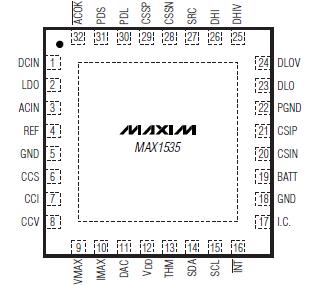Features: ` Compliant with Level 2 Smart Battery Charger Specifications Rev 1.1
` Intel SMBus 2-Wire Serial Interface
` ±0.5% Charge-Voltage Accuracy
` 11-Bit Charge-Voltage Resolution
` ±3% Input Current-Limit Accuracy
` Uses Small (10m) Current-Sense Resistors
` 8A Maximum Charge Current
` 6-Bit Input and Charge-Current Resolution
` 8V to 28V Input Voltage Range
` 175s Charge Safety Timer
` Automatic Selection of System Power Source
` Charges Any Battery Chemistry (Li+, NiCd, NiMH, Lead Acid, etc.)Application·Notebook and Subnotebook Computers
·Tablet PCs
·Portable Equipment with Rechargeable BatteriesPinout Specifications
SpecificationsDCIN, CSSP, CSSN, SRC, ACOK to GND ...............-0.3V to +30V
DHIV to SRC .........................................................-6V to +0.3V
DHI, PDL, PDS to GND ..............................-0.3V to VSRC + 0.3V
BATT, CSIP, CSIN to GND ....................................-0.3V to +20V
CSIP to CSIN, or CSSP to CSSN .........................-0.3V to +0.3V
CCI, CCS, CCV, DAC, REF to GND .............-0.3V to VLDO + 0.3V
VDD, ACIN, SCL, SDA, DLOV, LDO, THM,INT, IMAX,
VMAX to GND.........................................................-0.3V to +6V
DLOV to LDO.......................................................-0.3V to +0.3V
DLO to PGND...........................................-0.3V to VDLOV + 0.3V
PGND to GND .....................................................-0.3V to +0.3V
LDO Short-Circuit Current.................................................50mA
Continuous Power Dissipation (TA = +70)
32-Pin Thin QFN (derate 21.3mW/ above +70) .....1702mW
Operating Temperature Range ...........................-40 to +85
Junction Temperature......................................................+150
Storage Temperature Range .............................-60 to +150
Lead Temperature (soldering, 10s) .................................+300
Stresses beyond those listed under "Absolute Maximum Ratings" may cause permanent damage to the device. These are stress ratings only, and functional operation of the device at these or any other conditions beyond those indicated in the operational sections of the specifications is not implied. Exposure to absolute maximum rating conditions for extended periods may affect device reliability.
DescriptionThe MAX1535 is a highly integrated, multichemistry battery charger that simplifies construction of advanced smart chargers with a minimum number of external components.
It uses Intel's system management bus (SMBus) to control the charge voltage, charge current, and the maximum current drawn from the AC adapter.
High efficiency is achieved through use of a constant offtime step-down topology with synchronous rectification.
In addition to support of the Smart Battery Charger Specifications Rev 1.1, the MAX1535 includes additional features. The maximum current drawn from the AC adapter is programmable to avoid overloads when supplying the load and the battery charger simultaneously.
This enables the user to reduce the cost of the AC adapter. The MAX1535 provides a digital output that indicates the presence of an AC adapter. Based on the presence or absence of the AC adapter, the MAX1535 automatically selects the appropriate source for supplying power to the system by controlling two external Pchannel MOSFETs. Under system control, the MAX1535 allows the battery to undergo a relearning or conditioning cycle in which the battery is completely discharged through the system load and then recharged.
The MAX1535 is capable of charging 2, 3, or 4 lithiumion (Li+) cells in series, providing charge currents as high as 8A. The DC-to-DC converter in the MAX1535 uses a high-side P-channel switch with an N-channel synchronous rectifier. The charge current and input current- limit sense amplifiers have low input-offset errors and can use small-value sense resistors (0.01, typ).
The MAX1535 is available in a 5mm x 5mm 32-pin thin QFN package and operates over the extended -40 to +85 temperature range. An evaluation kit is available to reduce design time.

 MAX1535 Data Sheet
MAX1535 Data Sheet







